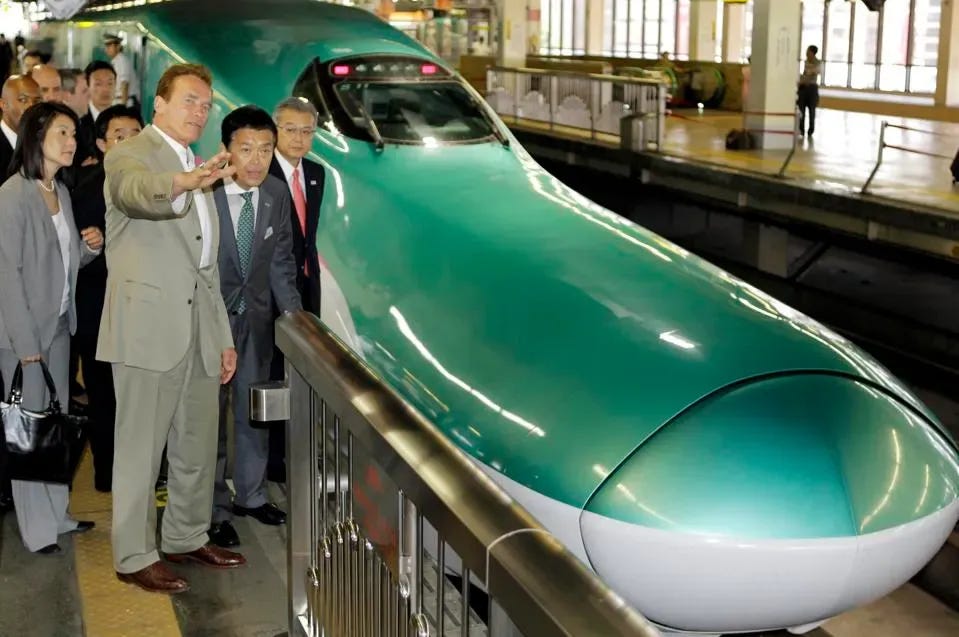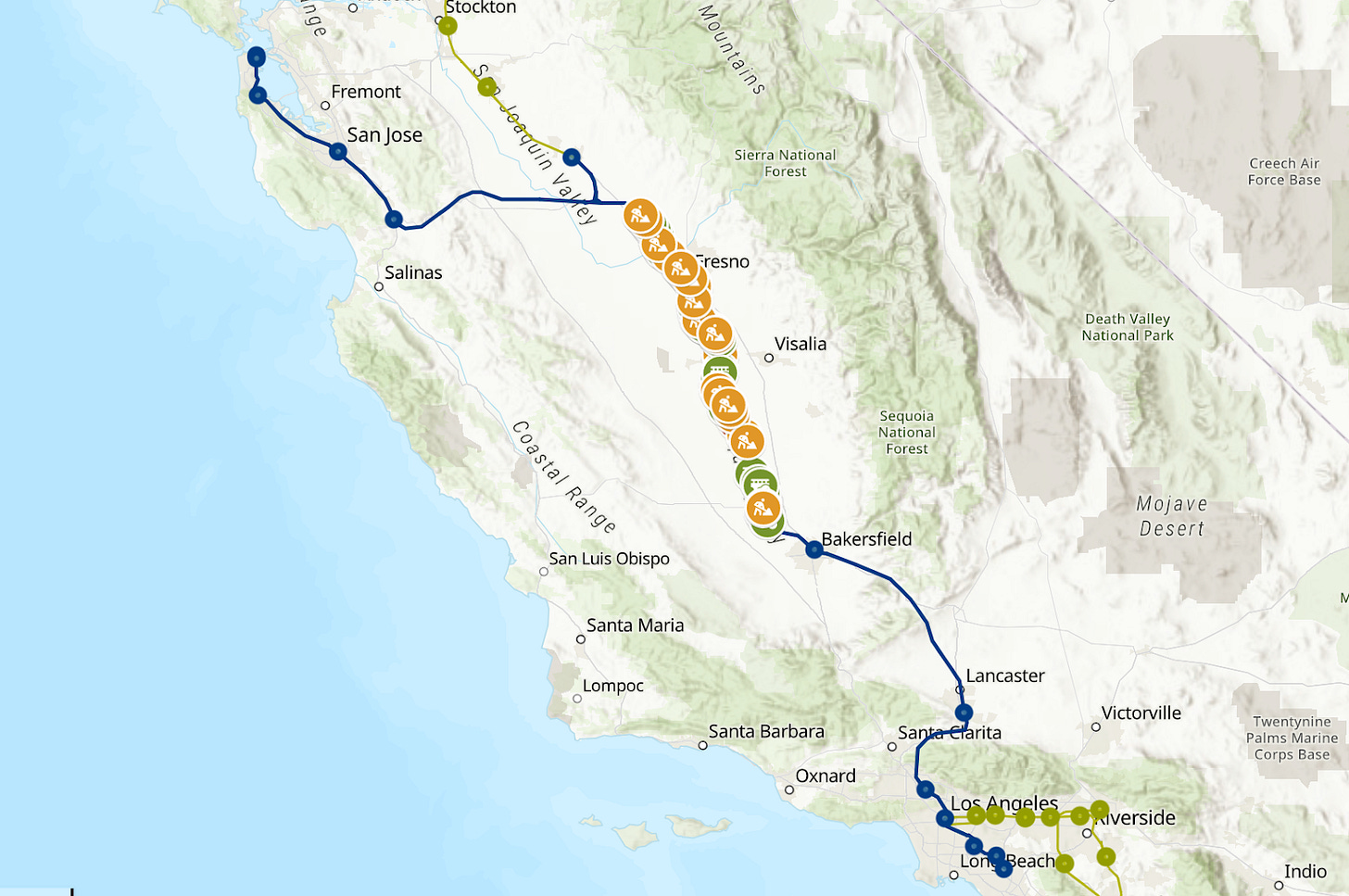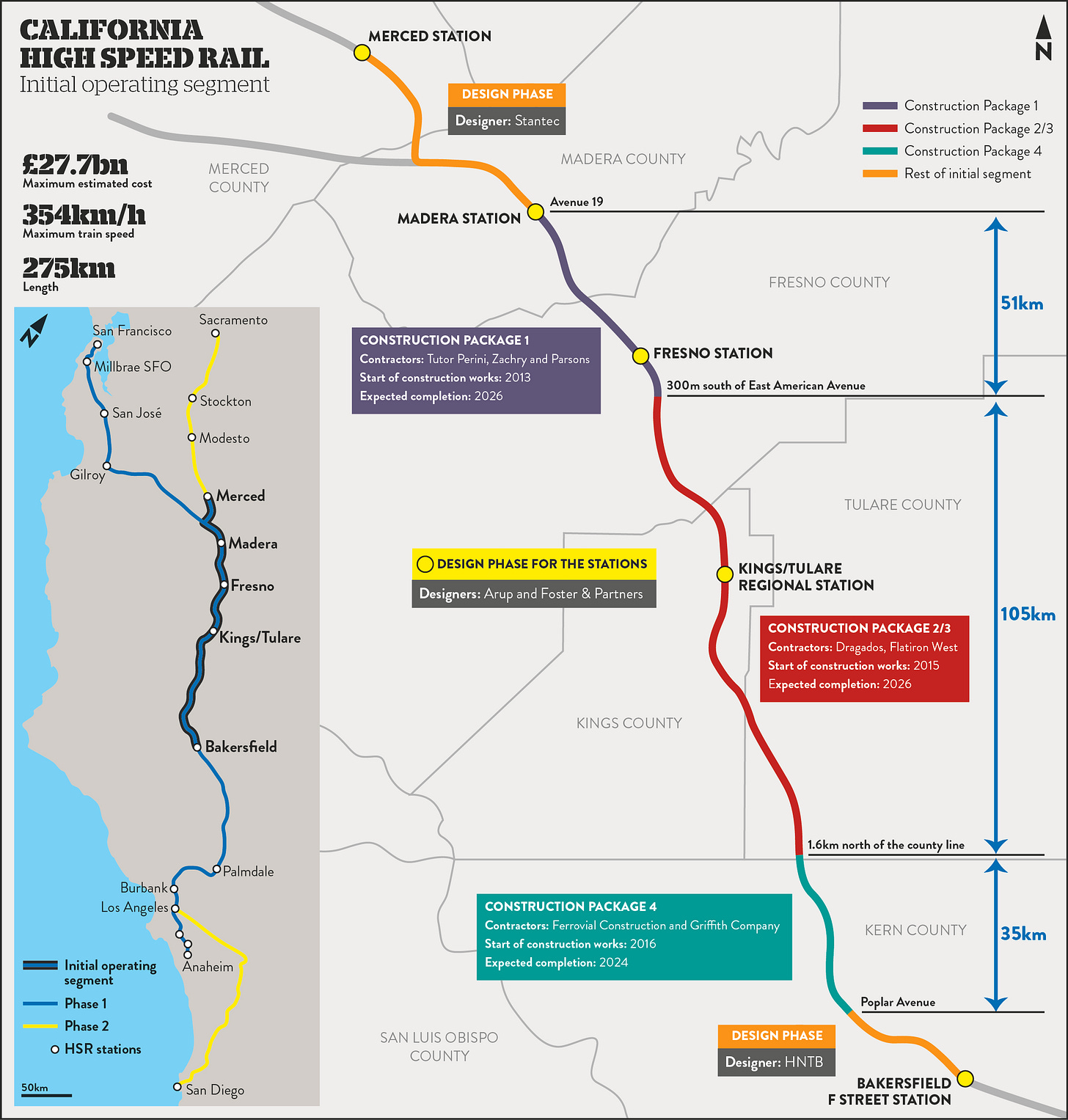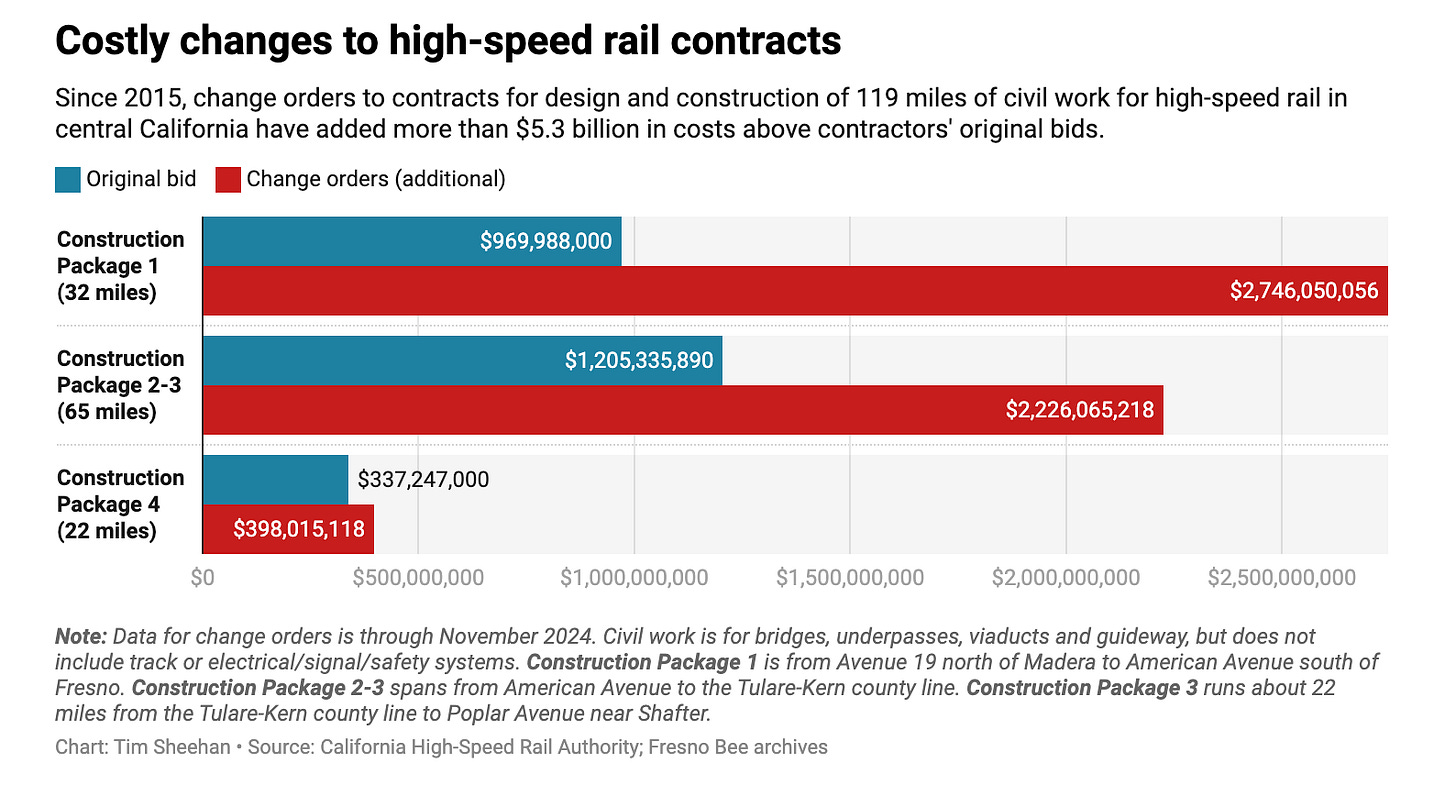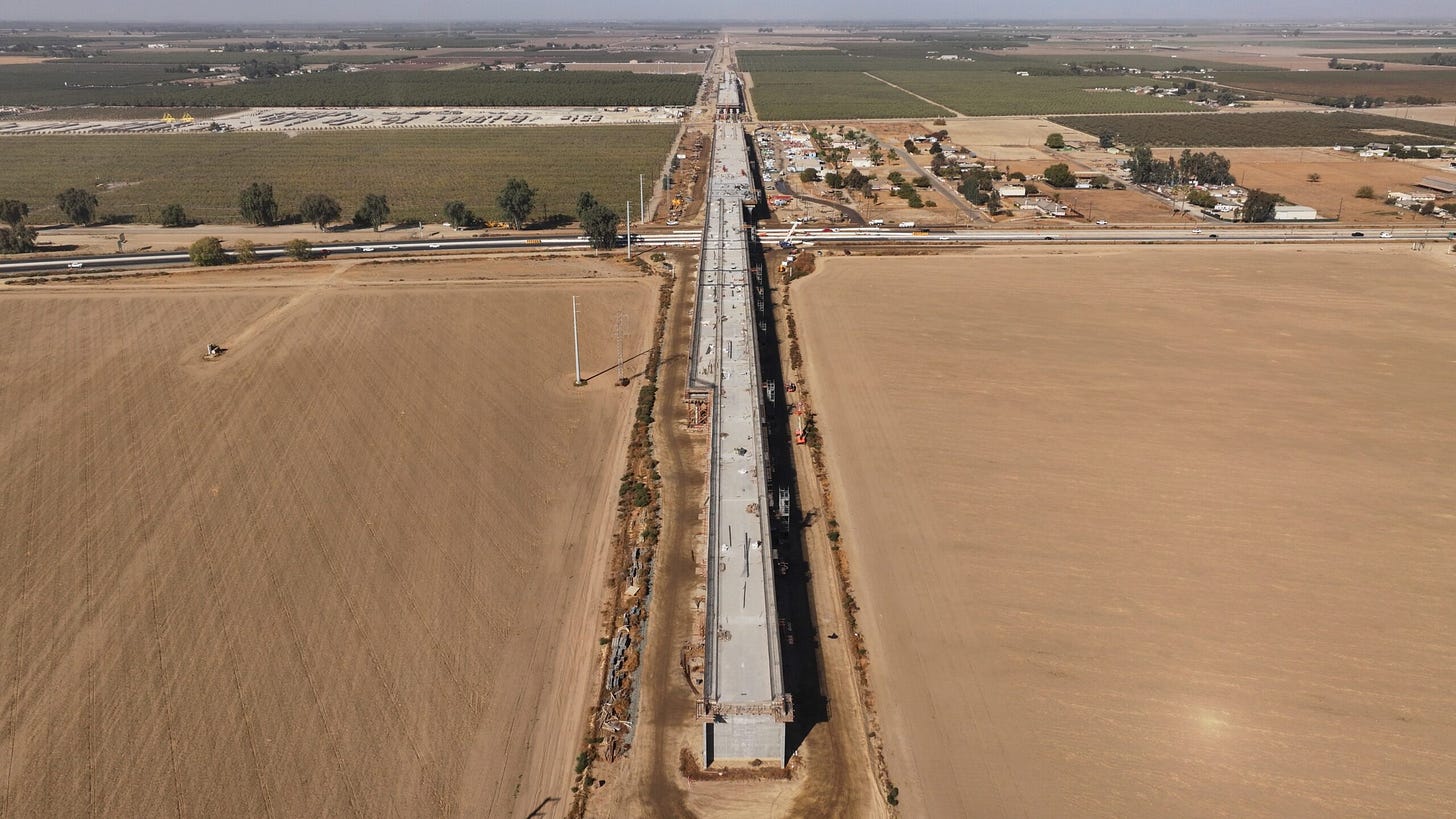The California High Speed Rail Megaproject
Will California manage to deliver its long promised high speed rail project?
Hi there,
Welcome to the first Off Site of the new year!
This week, we’re covering the most contentious infrastructure project in the United States: California High Speed Rail.
Elon Musk hates it. Supporters hate how it’s been handled. It needs up to $85 billion in additional funding.
But the project is underway, and it ultimately promises to connect tens of millions of people across Los Angeles, San Francisco, and the Central Valley.
Let’s dive in.
About California High Speed Rail
California High Speed Rail is a high-speed rail project with the initial aim of connecting Los Angeles and San Francisco. When finished, the line will be 800 miles long, with trains going over 200 miles per hour.
This has been a long-held dream by Californian politicians, first proposed by Governor Jerry Brown in 1979.
The current project launched in 2008, following a ballot measure championed by the Governator, Arnold Schwarzenegger. This plan was intended to have the full service from San Francisco to Los Angeles finished by 2020.
This… didn’t happen. As of writing, the only section currently under construction is the Central Valley, connecting smaller cities like Fresno and Bakersfield. There are no funded plans to connect this section with the metropolitan areas of San Francisco or Los Angeles.
The map below gives a sense of the project’s scope, with the blue line showing work that is yet to be started (or funded). The green line shows a proposed Phase 2, extending the line north to Sacramento and south to San Diego.
To complete the full Los Angeles to San Francisco line, the project will need an additional $85 billion.
How (not) to pick a route
How did things go wrong?
A detailed piece in the New York Times points to political interference. Rather than choose the most direct route from Los Angeles to San Francisco along the existing Interstate 5 corridor, the project made a series of political compromises.
As the Times writes:
The train’s path out of Los Angeles was diverted across a second mountain range to the rapidly growing suburbs of the Mojave Desert — a route whose most salient advantage appeared to be that it ran through the district of a powerful Los Angeles county supervisor.
These compromises added billions to the project cost of the railway — and added much more complexity around land acquisition and environmental approvals.
According to the Times, this led French national railway SNCF to leave the project in 2011 to work somewhere less politically dysfunctional: North Africa.
In the most devastating line of the article, the Times notes that Morocco’s “bullet train service launched in 2018.”
What’s actually being built
Dysfunction aside, a section of the line is currently under construction.
Known as the Initial Operating Segment, this section stretches 171 miles through the Central Valley of California. The work is divided into four construction packages.
The design and build of CP 1 is led by a Tutor-Perini, Zachry, and Parsons joint venture. The contract is currently valued at $3.6 billion. The project broke ground in 2013 and the expected completion date is 2026.
CP 1 runs 32 miles from Madera through the city of Fresno and includes twelve grade separations, two viaducts, one tunnel, and a crossing at the San Joaquin river.
The design and build of CP 2-3 is led by a Dragados and Flatiron joint venture. The contract is currently valued at over $3.4 billion. The project broke ground in 2015 and the expected completion date is 2026.
CP 2-3 runs 65 miles and includes 36 grade separations, including viaducts, underpasses and overpasses.
The design and build of CP 4 is led by a Ferrovial-Agroman and Griffith joint venture. The contract is currently valued at over $750 million. The project broke ground in 2016 and was declared complete this month.
CP 4 runs 22 miles and includes a range of overcrossings, viaducts and the relocation of existing tracks.
This graphic from New Civil Engineer gives an excellent overview of the different work packages.
How has the scope of work changed?
The Fresno Bee points out that every work package has faced significant changes, with hundreds of change orders approved over the course of the contract.
Because these change orders are publicly available, we thought we’d run some analysis to see any patterns.
There have been over 1500 change orders across the three packages to date.
For CP 1, there have been 651 change orders totalling $2.75B. Forty of these change orders have been over $10 million. The biggest single change order is $198.5 million for additional intrusion barriers.
26.1% of change orders on CP 1 are for ‘Changes to Plans and Specifications’ with 12.1% for ‘Utility Relocation.’
For CP 2-3, there have been 578 change orders totalling $2.23B. Thirty-nine of these change orders have been over $10 million. The biggest single change order is $242.1 million for the Hanford Viaduct superstructure (the largest high-speed rail structure in the Central Valley).
38.2% of change orders on CP 2-3 are for 'Changes to Plans and Specifications' with 14.0% for 'Administrative' matters.
For CP 4, there have been 288 change orders totalling $398M. Eleven of these change orders have been over $10 million. The biggest single change order is $40.5 million for a dispute resolution settlement.
25.3% of change orders on CP 4 are for 'Third-Party Related' issues with 19.8% for 'Environmental' matters.
Engineering challenges
If the full project is ever funded, it will face major engineering challenges connecting to either San Francisco or Los Angeles.
In the north, the project will need to tunnel through the Diablo Range at Pacheco Pass. At completion, this tunnel would be 13 miles long — the largest in the US.
According to Engineering News Record, “the project faces significant challenges in this area due to poor-quality rock formations, faults and shear zones, and potentially high groundwater inflows that can affect tunnel stability.”
The situation isn’t any easier in the south, with 36 miles of tunnels proposed, including 28 through the San Gabriel mountain ranges into the Los Angeles basin.
Tunnel boring machines have been identified as the best method for both proposed projects.
Will it ever finish?
Well-sourced commentators like Ezra Klein argue that the project will not be finished in its current form. There simply isn’t the money available, especially federally following the reelection of Donald Trump.
The original justification for the project — to reduce reliance on car and air travel in the most populous regions of the state — remains persuasive. But critics continue to argue that the opportunity cost is too great and the timeline too distant to make a meaningful impact on climate change.
That said, at the time of writing, Governor Newsom of California is still bullish on the long term prospects of the plan, recently announcing a $310 billion plan for rail across California. As some have pointed out, the project may have become too big to fail.
What we’re reading
Highly recommend reading the full breakdown of the CaHSR from the New York Times.
A brilliant deep drive from New Civil Engineer into the erosion of a seaside village in Norfolk, with some startling aerial photographs.
As always, Last Week in Contech is a great read.


